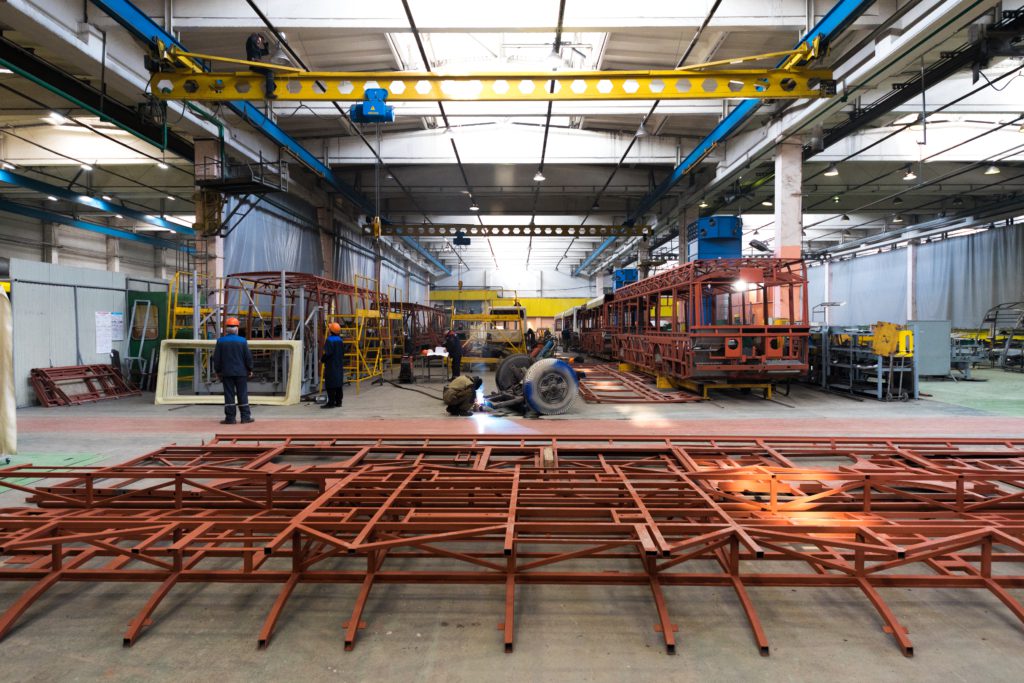TMT Bars are one of the most essential construction requirements. They are what became the foundation of all the incredible infrastructural creations we see around us. They provide structure, stability and strength to the buildings. So, the TMT bars used must be of the highest quality, which can positively impact the construction process. This can be ensured during the TMT bars manufacturing process.
Now, let us understand how the TMT bars manufacturing process can impact the standards of the construction industry.
TMT Bars Manufacturing Process

1. Scrap Collection and Sorting
The first stage isn’t strictly scrap collection, but rather raw material preparation. Here, various sources of iron-bearing materials are accumulated and sorted. Using magnetic separators, the steel scrap is meticulously categorised based on its chemical composition. This ensures the final TMT bar possesses a uniform and predictable chemistry.
2. Raw Material to Billet
After melting, the molten metal is poured into a large container called a casting ladle. The ladle allows the slag, a lighter layer of impurities, to float to the top. This slag is cleaned off, leaving the cleaner liquid metal below. This liquid isn’t pure steel yet, but it’s enriched in iron. It is next cast into shapes like billets for further processing into steel.
3. Forming the bar from billets
The heated billet enters the rolling mill stand, a rigid housing containing multiple hardened steel rolls. These rolls are precisely positioned and adjusted to create a specific gap. As the billet is forced through this gap by powerful drives on the rolls, the immense pressure causes the metal to deform. This deformation squeezes the billet’s cross-section, reducing its thickness and elongating its length to achieve the desired final dimensions.
4. Quenching
This is where the hot TMT bars, fresh from the rolls, are rapidly cooled. This creates a dual-phase structure – a tough outer layer and a more ductile core. The outer layer forms a protective “martensite” layer due to the sudden temperature drop, while the core remains flexible and capable of absorbing energy during stress.
5. Tempering
Under the tempering process, the bars are heated and cooled to a controlled temperature. This process makes the TMT bars stronger and tougher so that they can bend more without breaking.
What sets Jumbo’s TMT Bars apart?

Jumb’s TMT bars manufacturing process or as we like to call it the Jumbo Factor is the use of Tungsten to strengthen the TMT bars even more and prevent them from breaking under immense pressure. With the ultra-tungsten technology, German Thermax quenching and self-tempering, it is assured that the TMT bars have unparalleled strength and durability.
How does the manufacturing process impact the standards of the construction industry?

The TMT bars manufacturing process significantly impacts the standards of the construction industry. The properties and the strength of the TMT bars ensure that they are safe, durable and suitable for laying the foundation of a long-lasting structure.
1. Enhanced Strength and Resistance to Shocks and Pressure
TMT bars undergo a multi-step process to make sure that they are up to industry standard, i.e., have great strength and do not crumble under pressure. Stronger bars can bear heavier loads and resist pressures caused by natural factors like earthquakes.
2. Improved Ductility and Bendability
The thermo-mechanical treatment provides greater ductility to the TMT bars. This means that they can bend without breaking. They can also absorb great blows of impact without shaking the structural foundation.
3. Corrosion Resistance
The TMT bars manufacturing process when done with great detail ensures that the bars can withstand the tests of time and resist corrosion for a long time. Bars which can resist corrosion are very important to ensure the longevity of the infrastructure.
4. Meeting Industry Standards
Meeting the standards set by the regulatory bodies ensures that buildings follow all the safety codes and can withstand various environmental factors over an extended lifespan.
Some grades and industry standards as set by the Bureau of Indian Standards (BIS) are as follows:
- Some common TMT bar grades include Fe415, Fe500, Fe550, and Fe600.
- The primary standard for TMT bars is IS 1786:2008.
- The chemical composition of TMT bars includes specific proportions of elements like carbon, sulphur, phosphorus and manganese. It is essential to ensure that these composition standards are maintained.
| Properties | ISI Standard FE 500 | Jumbo TMX FE 500 | Jumbo TMX FE 500 | Jumbo TMX FE 500D |
| Carbon % | 0.3 | 0.25 | 0.25 | 0.23 |
| Sulphur % | 0.055 | 0.05 | 0.04 | 0.035 |
| Phosphorus % | 0.055 | 0.05 | 0.04 | 0.035 |
| S+P % | 0.105 | 0.1 | 0.075 | 0.07 |
- To attain specified mechanical standards, TMT bars must meet specific values for properties like yield strength, tensile strength, and elongation.
| Properties | ISI Standard FE 500 | Jumbo TMX FE 500 | Jumbo TMX FE 500 | Jumbo TMX FE 500D |
| Yield Stress (Min.) | 500 | 530 | 500 | 530 |
| Tensile Strength (Min.) | 545 | 600 | 565 | 610 |
| Elongation (Min.) | 12% | 16% | 16% | 18% |
Conclusion
From the above points, it can be noted that the TMT bars manufacturing process impacts the construction industry standard a great deal. They determine how well the lifespan of an infrastructure would be and how safe it will be as well. These bars are the foundation of the dreams of so many people and it is necessary to make sure that these dreams remain safe and secure for a long long time.
Don’t let any dreams crumble under pressure, Choose Jumbo TMX and soar to heights by building incredible infrastructures.





